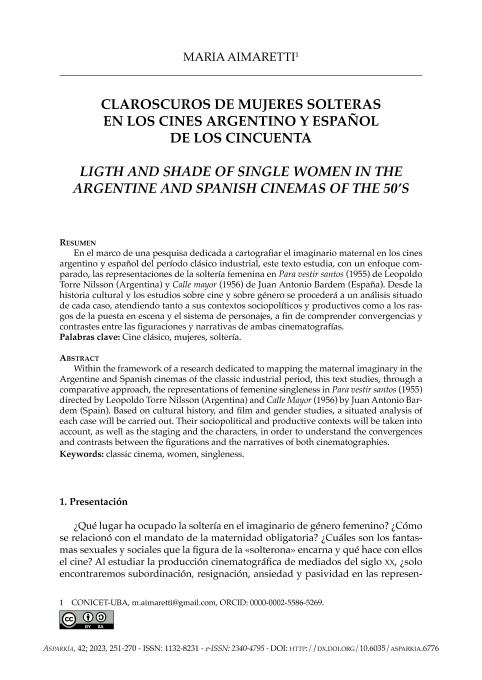Artículo
En el marco de una pesquisa dedicada a cartografiar el imaginario maternal en los cines argentino y español del período clásico industrial, este texto estudia, con un enfoque comparado, las representaciones de la soltería femenina en Para vestir santos (1955) de Leopoldo Torre Nilsson (Argentina) y Calle mayor (1956) de Juan Antonio Bardem (España). Desde la historia cultural y los estudios sobre cine y sobre género se procederá a un análisis situado de cada caso, atendiendo tanto a sus contextos sociopoliticos y productivos como a los rasgos de la puesta en escena y el sistema de personajes, a fin de comprender convergencias y contrastes entre las figuraciones y narrativas de ambas cinematografías. Within the framework of a research dedicated to mapping the maternal imaginary in the Argentine and Spanish cinemas of the classic industrial period, this text studies, through a comparative approach, the representations of femenine singleness in Para vestir santos (1955) directed by Leopoldo Torre Nilsson (Argentina) and Calle Mayor (1956) by Juan Antonio Bardem (Spain). Based on cultural history, and film and gender studies, a situated analysis of each case will be carried out. Their sociopolitical and productive contexts will be taken into account, as well as the staging and the characters, in order to understand the convergences and contrasts between the figurations and the narratives of both cinematographies.
Claroscuros de mujeres solteras en los cines argentino y español de los cincuenta
Título:
Ligth and shade of single women in the argentine and spanish cinemas of the 50's
Fecha de publicación:
06/2023
Editorial:
Universitat Jaume I
Revista:
Asparkia
ISSN:
1132-8231
e-ISSN:
2340-4795
Idioma:
Español
Tipo de recurso:
Artículo publicado
Clasificación temática:
Resumen
Palabras clave:
CINE CLÁSICO
,
MUJERES
,
MATERNIDAD
,
SOLTERÍA
Archivos asociados
Licencia
Identificadores
Colecciones
Articulos(SEDE CENTRAL)
Articulos de SEDE CENTRAL
Articulos de SEDE CENTRAL
Citación
Aimaretti, Maria Gabriela; Claroscuros de mujeres solteras en los cines argentino y español de los cincuenta; Universitat Jaume I; Asparkia; 42; 6-2023; 251-270
Compartir
Altmétricas




